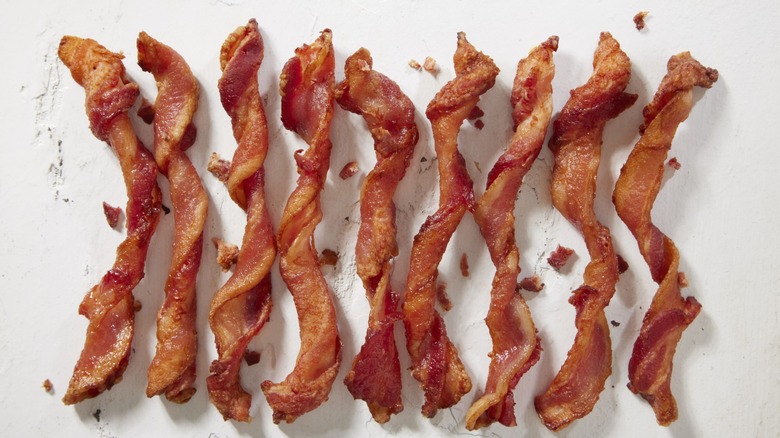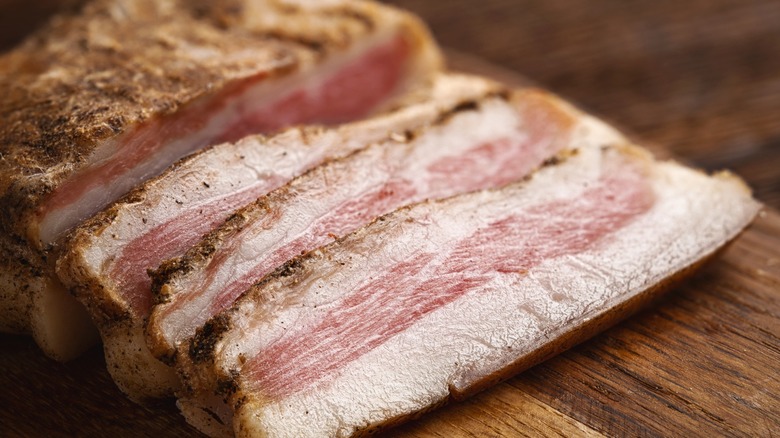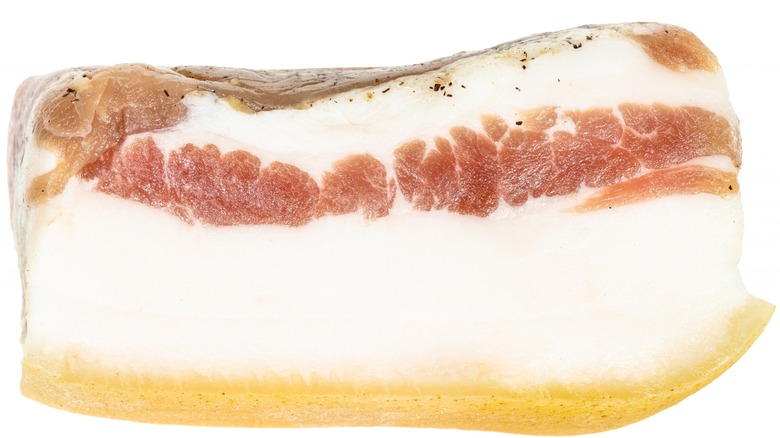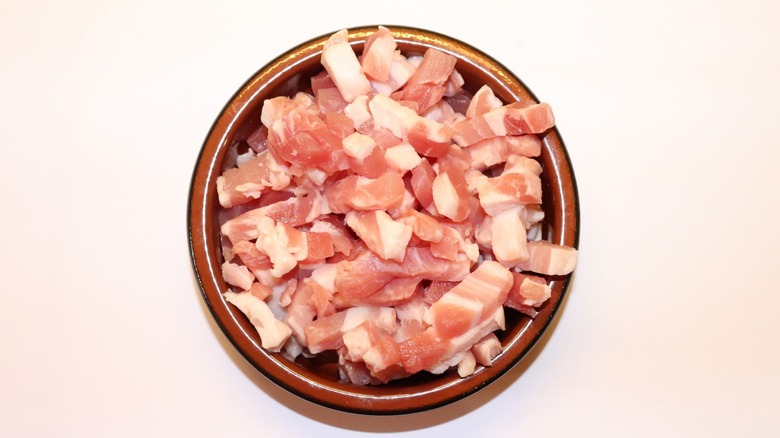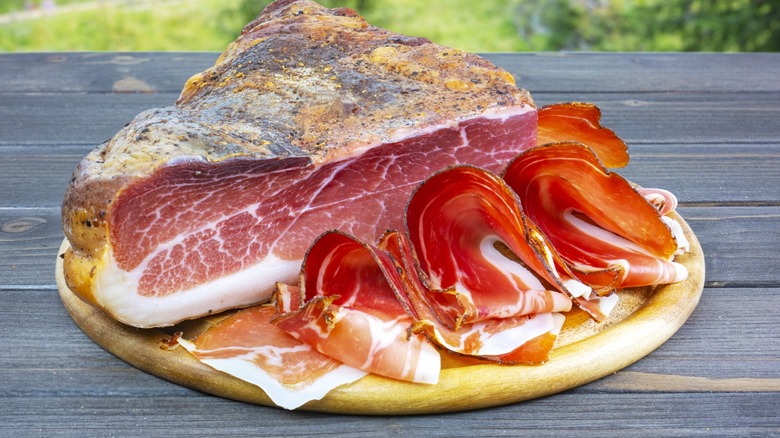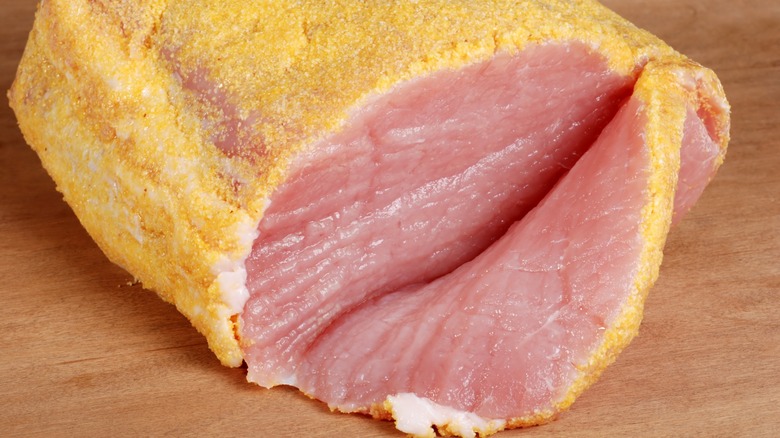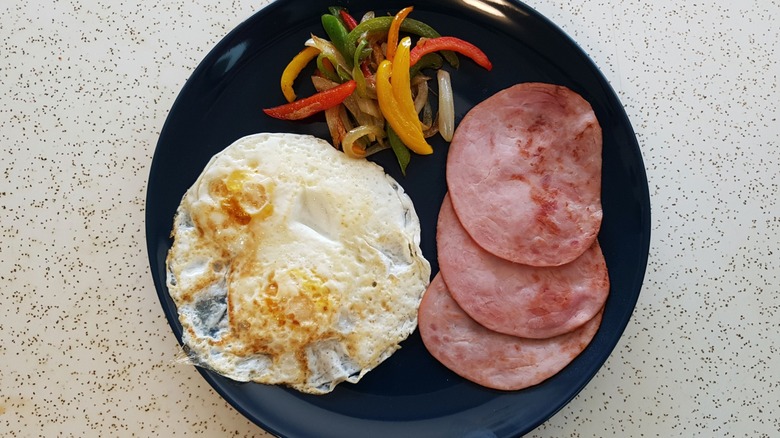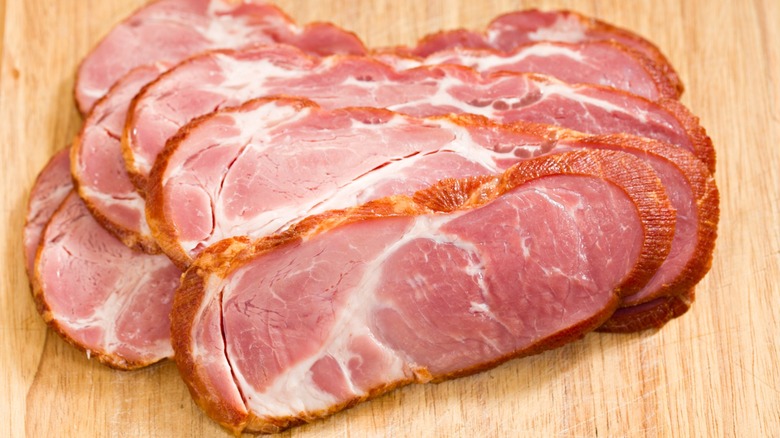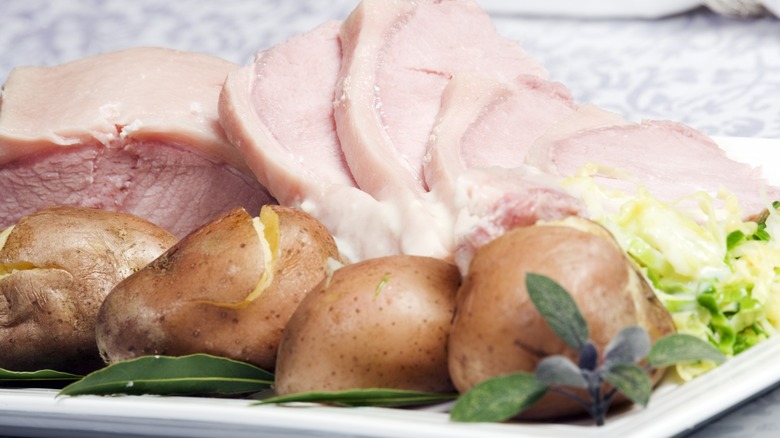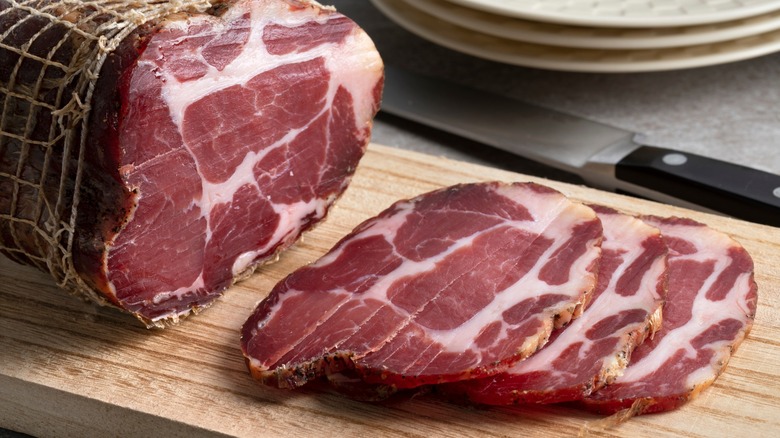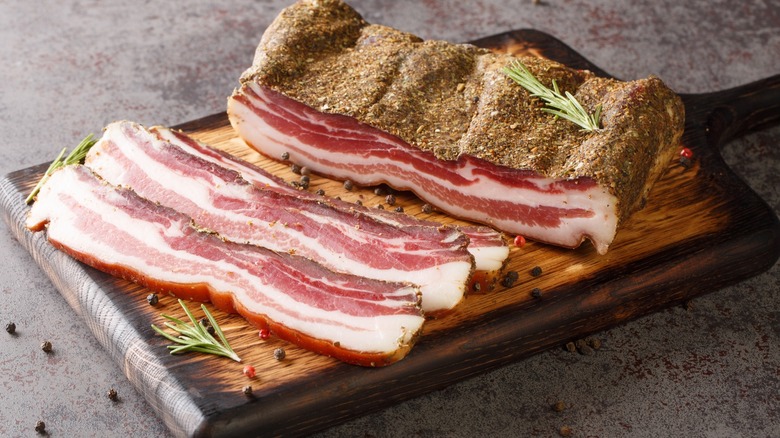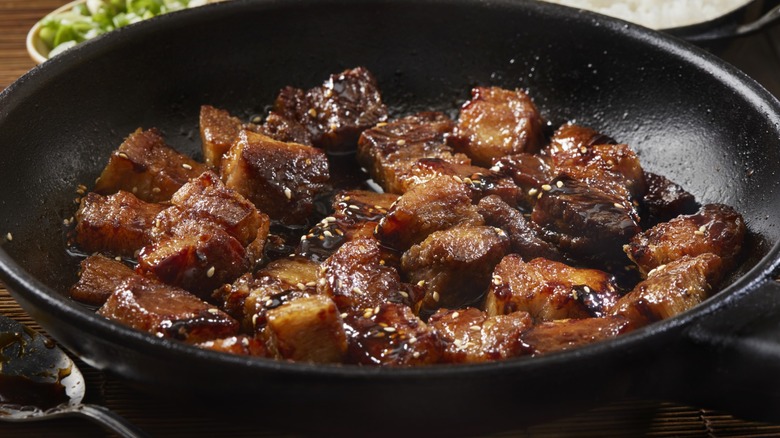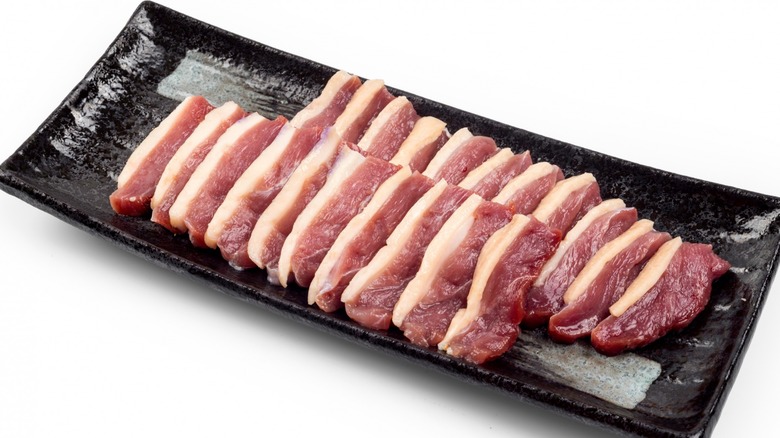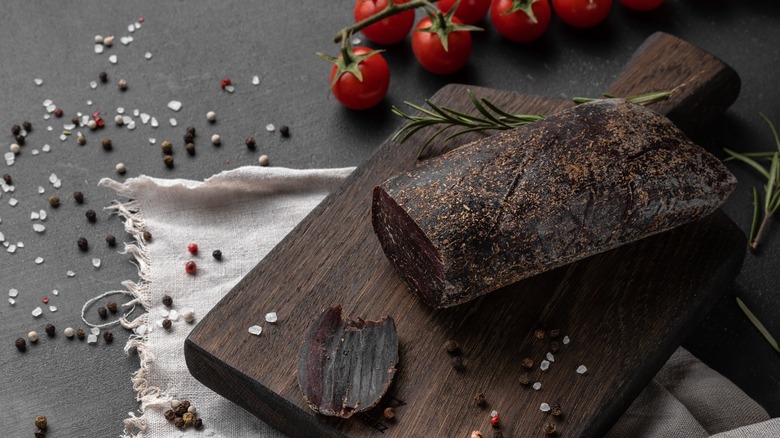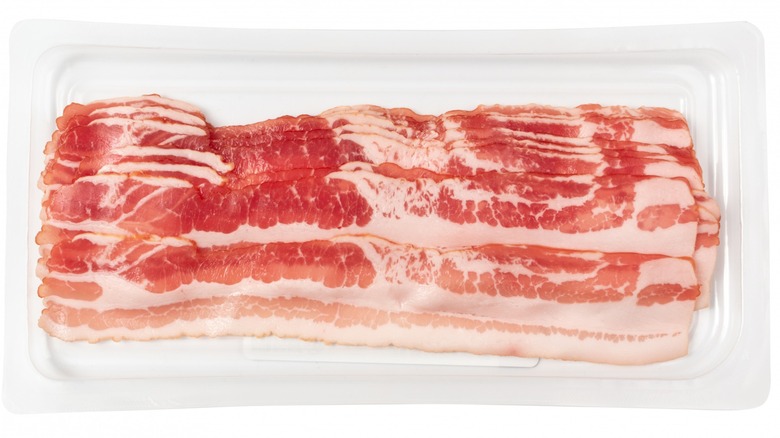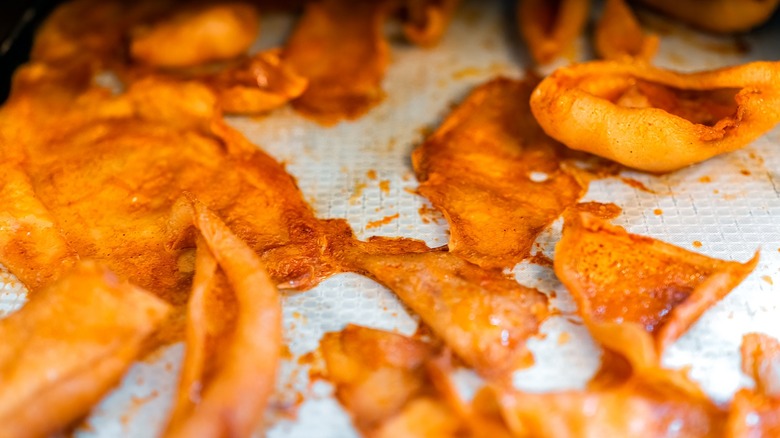15 Bacon Varieties You Didn't Know Existed
Bacon is the quintessential breakfast food, perfect alongside a plate of eggs or pancakes. Some people like it crunchy and almost burnt, others like it moist and chewy. That delicious side of meat is so mouth-watering that it draws everyone out of bed to the breakfast table, even if people disagree on the best ways to cook bacon.
But, not all bacon is created equal. For example, different countries get their cuts from different parts of the pig. And, bacon producers have different ways to process or cure it. We all know about turkey bacon, but other animals are also used for bacon. While bacon usually comes in thin slices, it's also available unsliced, otherwise known as slab bacon. Different cuts can make for a unique dining experience.
These bacon varieties are just that — unique. What they do have in common is that they are all cured (even uncured bacon), are often salted, and are sometimes smoked, providing that delicious, bacon-y taste experience. You'll want these bacon varieties on your table any time of day.
1. Guanciale
A staple in many Italian recipes, guanciale comes from the word for "cheek" in Italian, and that's exactly the part of the pig this bacon comes from. Here in America, it is often called jowl bacon. This cut of bacon is most popular in the region around Rome. It graces dishes like spaghetti carbonara and pasta alla Gricia, where the flavor of the bacon breaks up the taste of rich, creamy sauces. Guanciale is also commonly used for amatriciana, a spicy, tomato-based pasta dish.
Guanciale is very fatty and saltier than other varieties of bacon. Most often, guanciale is cured with salts, spices, and sugar and cut into tiny strips that are perfect for mixing into sauces. Unfortunately, it's not easy to find. We recommend you check for it at an Italian specialty shop. If you can't find guanciale, you might have better luck finding pork jowl, but it won't be cut into small pieces. Jowl bacon is also used in Chinese cooking, so you can also search for it in your local Asian food shops.
2. Szalonna
Szalonna is a popular cured meat in Hungary. While Hungarians don't consider it to be bacon, many varieties of szalonna look and act like it, so we don't mind the designation. There's no one-size-fits-all for this cured meat. Szalonna is highly salted, cured in brine, and then naturally smoked, keeping as much of the fat intact as possible. Some varieties have little actual meat content. Cooking is not required, but sautéed szalonna with onions and paprika is a favorite dish in Hungary.
Even for such a simple dish, there is plenty of variety because no two types of szalonna are alike. It comes in many shapes and types, depending on what part of the pig is used and how it's processed, cut, cured, and salted. For example, gourmet szalonna comes from the fat on the back of the pig. The slices are several inches thick and bright white due to their high fat content. It has a layer of skin, making it stand out from other varieties.
On the other hand, Kolozsvári szalonna, named for the region in Hungary where it was created, comes from pork belly. This bacon is cut into large slabs, has skin on the bottom, and is much meatier than gourmet. With over 50 varieties, we guarantee that no two dishes will taste the same!
3. Lardon
Hailing from France, lardons are tiny yet thick rectangular slices of bacon or pork fat, often added when cooking meat dishes. Lardons were used historically in France for larding. Centuries ago, everyday meat was very dry and tough but could be moisturized through the process of larding. This involved hand sewing pieces of lardon into a dry cut using specially made needles. Today, meat is raised in a way that produces tender beef, and, therefore, larding is no longer necessary.
But, lardons are still available today. They complement roasts, stews, and casseroles, especially if they contain beef. You can also toss lardons into salads, use them to make a heartier vegetable dish (think green beans), or add them to quiches and omelets. Another option is to use them to flavor bland dishes that are made with potatoes or pasta. Lardon is also a great substitute for guanciale.
And, you can always make your own lardon using thick-sliced or slab bacon. Cut it into small strips, about ½ wide by one inch wide, then immerse the pieces in boiling water for several minutes to remove extra fat and salt. Now, you can add it to your recipe!
4. Speck
Hailing from the Northern Italian and Austrian regions of Europe, speck is a cured meat that lies somewhere between bacon and ham. There's much confusion about the origins of speck, which is sometimes erroneously called German bacon. Italian meat connoisseurs often claim it as belonging to them, going so far as to claim to corner the market on "authentic" speck.
Either way, this delicacy gives standard bacon a run for its money. While similar in composition, speck is less fatty because pork thighs are used for this variety. Like other top-flight cuts of meat, pigs used for speck are raised to strict standards because the production of this cured meat is highly regulated in Italy. For example, manufacturers and producers are not allowed to freeze it.
Before it is smoked, speck is marinated in a special spice mixture for a few days or weeks. These marinades vary for each producer, but juniper berries and bay leaves are usually part of the mix. Speck stands out as another great bacon choice that has a lot of appeal and variety.
5. Peameal or cornmeal bacon
This take on bacon comes from Canada. The meat is taken from the back of the pig and is wet-cured. Once the fat is sliced off, the meat is rolled in cornmeal. Historically, this bacon was rolled in a mixture created from yellow peas, and the name peameal stuck.
Its origins are murky, but William Davies is most commonly credited with its creation. In the 1900s, demand for bacon in the U.K. was high from the era of Queen Victoria through World War II due to shortages. Davies' Toronto-based pork factory was one of the biggest producers of its time and his peameal bacon helped fill that void.
Peameal bacon comes from the pig's back. Like American bacon, it cannot be served raw. It's also less fatty and holds more juice than the American type. A great thing about peameal bacon is that it's difficult to overcook this dish. The downside? You might have difficulty finding this cut outside of Canada.
6. Canadian bacon
What Americans call Canadian bacon isn't Canadian at all; it's actually an American creation. In fact, if you buy bacon in Canada, it's most likely peameal. So, what's the story here? When the British started importing peameal bacon from Canada, they initially called it Canadian bacon instead of peameal. Brits were partial to smoking it, which made it taste more like ham. Today, Brits no longer call it Canadian bacon and have created their own style of bacon.
Eventually, Americans got a hold of the British Canadian bacon, and that's why today, this version of Canadian bacon is only found in America. It's really just a smoked version of peameal (now made with cornmeal) bacon that came to America via the U.K. This meat may have a complicated history, but we still love it on one of our favorite American diner staples, eggs benedict. You can also enjoy it as a pizza topping, but we'll leave the debate about whether to add pineapple chunks to your pizza for another day.
7. Cottage bacon
Also called buckboard bacon, this type of bacon also comes from a different part of the pig — either the shoulder or the end of the pork loin. Cottage bacon is cured until a skin is formed, then the meat is smoked. Producers use a variety of spice blends for curing and rubbing, so you might get a different flavor depending on how it was prepared.
Cottage bacon has a very different appearance than traditional bacon. Instead of long, thin strips, it comes in slices shaped like an oval with a flat bottom. When cooked, it's darker in color because it has less fat, but it looks more like ham when raw. That means it has a richer flavor, compared to some other types of bacon. Cuts of this bacon also tend to be thick. With less saturated fat than traditional bacon and a shape better suited for sandwiches, we recommend changing up your regular BLT sandwiches with this cut!
8. Irish and British bacon
Like Canadian bacon, Irish bacon is usually sourced from back meat, although it sometimes comes from the shoulder. Diners may think cooked Irish bacon is still raw because of its pink color. This cured meat is typically boiled first, then cured. It may also be smoked. If so, this process is stopped just as the meat reaches the designation of "cooked." Like cottage bacon, it has a round shape. Irish bacon and cabbage with parsley sauce is a popular dish in Ireland. The meat is also traditionally served with a side of colcannon, which is a blend of mashed potatoes and cabbage or kale. It's a great addition to corned beef or hash recipes.
Irish bacon's nearby cousin, British bacon, is mostly comprised of pork loin with much of the fat left on. This cut of meat is butchered all the way to the pork belly that it's connected to. In England, cured loin pieces are called rashers, while cured belly, which resembles American bacon, is called streaky. Hopefully, that'll make it easier to order the next time you have breakfast in London!
9. Collar bacon
Not surprisingly, bacon that is sourced from the collar and neck area of the pig is called collar bacon, but it can also contain parts of the shoulder. This cut has connective tissues that run through it, so it takes longer to cure. That also means it requires a longer cooking time, especially when boiled, which is the traditional way to cook it.
Collar bacon has a higher fat content and richer flavor profile than back bacon. It's a choice option for smoked dishes. The slices are completely round with a dark red color and marbled with a few veins of fat.
At the butcher, you can buy collar bacon joints, which deliver plenty of flavor at a lower cost than most other bacon cuts. These are excellent for roasts or slow-cooker meals. Collar bacon can be cooked like typical bacon in a pan, or you can buy a whole piece and stuff it with seasoning for a meal that's part crispy bacon and part holiday ham!
10. Pancetta
This is another Italian cured meat. Like American bacon, it's derived from pork belly, but it differs in many ways. Both are cured with salt, but pancetta is also rubbed with salt before curing, which may explain its extra-salty flavor. Another difference is that pancetta is rarely smoked, but when it is, only a cold-smoke process is used. Finally, American bacon always needs to be cooked, while dried pancetta does not.
Pancetta differs from other Italian cured meats due to the length of curing time, which is no more than two months. Compare that to prosciutto, which may be cured for up to a year. This meat has a robust, savory flavor that is distinctive because the brine always includes black pepper. Other than that, blends vary greatly. You'll find uncut pancetta at the butcher shop, but it comes cubed in most packaged products. Pancetta is a great accompaniment to the same pasta dishes as guanciale. It's also often used to spice up mildly flavored dishes such as eggs, beans, potatoes, or polenta pie.
11. Lap yuk
This Chinese version of bacon, lap yuk, has a history dating back 2000 years when it was often used as a tasty meat that could last during a long trip. The curing was achieved by leaving salted pork belly meat in the sun. It became so popular during China's Tang dynasty, which ran from the 7th to 10th centuries, that one ruler created a law requiring every home to stock Chinese bacon.
Lap yuk is sourced from pork belly, then smoked. Its unique seasonings include salt, sugar, five-spice powder, soy sauce, and rice wine, giving it a unique flavor that is sweet, spicy, and smoky. The fattest part of the pig's belly is usually chosen for this bacon, so it has a very high fat content. In China, lap yuk is typically fried or roasted for breakfast, and steamed or braised for other meals. Other popular uses for Chinese bacon include adding flavor to soups and stews and, naturally, as a popular addition to any stir-fry meal. Lap yuk should not be confused with lap cheong, which is a Chinese sausage.
12. Duck bacon
Fans of duck meat will not be surprised to learn that they can buy duck bacon. What might be surprising is that this bacon is made from duck legs. The meat from this region is slow-cooked, spiced, and cured. Some varieties are also smoked. Duck bacon is leaner than traditional bacon and, like most duck meat, can be gamey. The flavor is quite rich, smoky, and a bit sweet. If you love duck confit, you'll love this bacon. Plus, it's an excellent choice if you like your bacon crispy and lower in fat.
You can use duck bacon as an alternate choice for your BLT sandwiches, in salad, on seafood, and sprinkled on a pasta dish. (Pasta seems to be a natural choice for all kinds of bacon!) One of the advantages of duck bacon is that you can render the fat and store it to add hearty flavor to braises, sauces, and stir-fry vegetable dishes. Simply pan-cook it as you would any other bacon and save the fat.
13. Elk bacon
Duck and turkey bacon may be interesting choices for bacon, but more exotic meats can be used, including elk bacon. If you've never heard of elk meat, don't worry. Elk is a member of the deer family. If you've had venison, you've eaten similar meat. Elk bacon meat is sourced from elk bellies. It is often cured with sweet ingredients, such as cane sugar and brown sugar, then smoked. It has a sweet and smoky flavor with a different texture than pork bacon. This bacon is leaner, and, therefore, a good choice if you're looking to limit your fat intake.
However, sourcing elk bacon in the U.S. is not easy. Elk, however, is a common hunting game and many people cure their own elk bacon. You should know that wild-caught elk will have a stronger, smokier, and gamier flavor but otherwise is similar to the taste of grass-fed beef.
14. Beef bacon
Bacon sourced from beef is an excellent choice for people who can't have pork. In fact, you probably have already tried beef bacon and didn't know it. According to Marc Zimmerman, owner of GOZU in San Francisco and co-founder of A-Five Meats, "If bacon is on the menu in the restaurant, it's coming from a cow."
Beef bacon is sourced from a cow's belly, and is then cured, dried, and smoked before it's sliced. It has become a popular trend thanks to demand from Middle Eastern countries, where pork is rarely eaten. It doesn't taste like typical American bacon, but if you prefer beef to pork, we recommend you try this variety. It does have a strong meat flavor without that pork twang. The great thing about beef bacon is that it's readily available in your local grocery store or butcher shop. Try it as a substitute for all your bacon needs.
15. Coconut bacon
It's said that almost everyone loves bacon — unless, of course, you're vegan or vegetarian. But, never fear, there is a solution: coconut bacon! This is also a great choice for people who don't want fatty meats in their diet.
You can buy coconut bacon, but if you have a dehydrator, you can make it at home exactly to your taste using coconut flakes. You can also bake or fry them. To achieve a bacony flavor, season with soy sauce, liquid smoke, and spices. Other options include maple syrup, salt, and chipotle powder. We recommend you experiment with the seasonings so that a heavy coconut flavor does not come through. You may also want to avoid this dish if you avoid soy. Using coconut aminos, a common soy sauce replacement, will likely make it taste too much like coconut.
Coconut bacon is low in fat and high in fiber compared to any other type of bacon. Now that you know what coconut bacon is, you can use it to change up your bacon recipes, especially when making a sweet and savory dish or snack.
